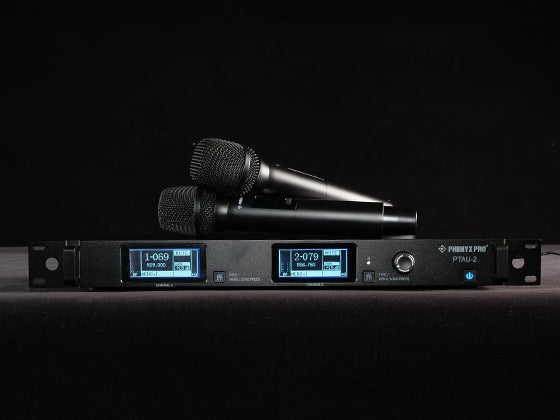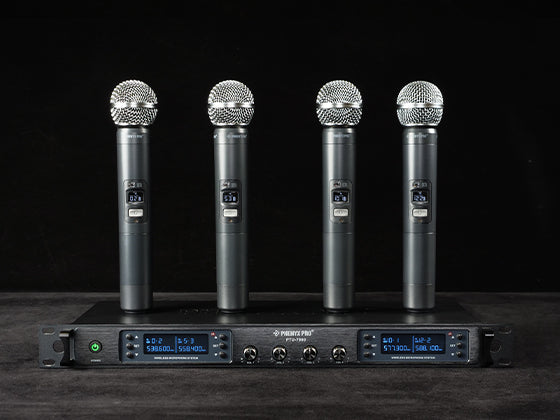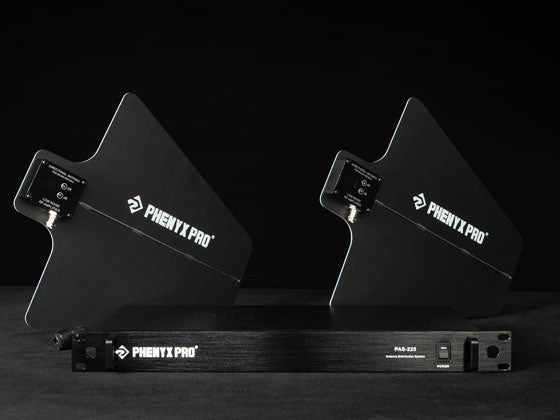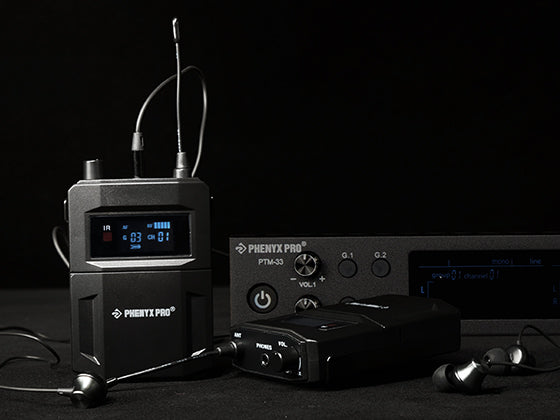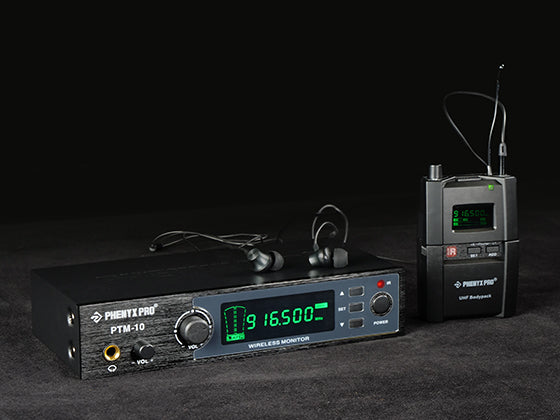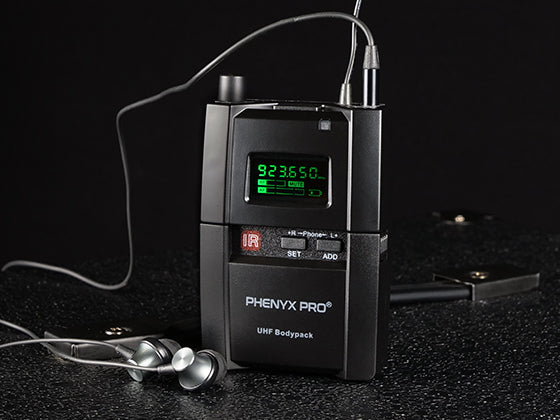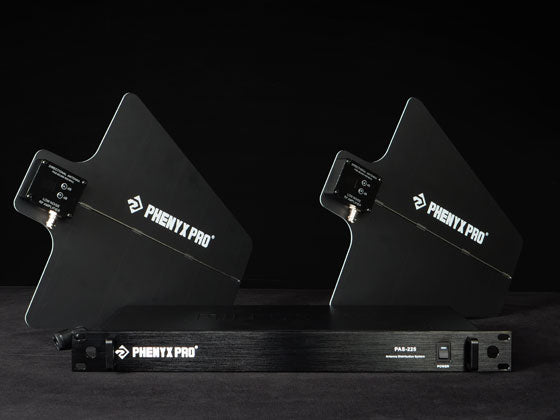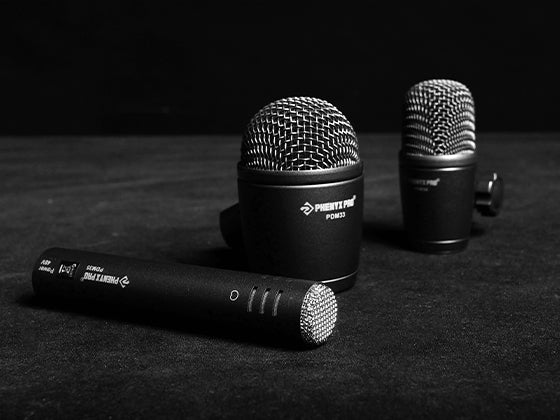Mono vs. Stereo:
The Ultimate Wireless IEM Buying Guide
Discover the monitoring solution that fits you with Phenyx Pro’s Mono (PTM-11/22/33) and Stereo (PTM-10) Monitoring Series. Dive into this insightful blog and explore their differences so as to make a suitable buying decision to gear up for your sound monitoring journey.

This May, Phenyx Pro officially launched the PTM-33, a quad-channel model of the Mono Monitoring Series, sparking heated discussions on the PTM-33 and its comparison to the PTM-10. This blog offers an in-depth comparison of these two series, providing practical insights to guide your purchasing decisions.
Understanding the Differences
Phenyx Pro provides two series of wireless in-ear monitoring systems, the Mono Monitoring Series and the Stereo Monitoring Series. Before diving into the comparison, let’s briefly figure out why these series were developed, the issues they address, and their target user group.
Mono Monitoring Series, comprising the single-channel PTM-11, dual-channel PTM-22, and quad-channel PTM-33, serves as an entry-level in-ear monitoring solution for live performances. Generally, it provides more connections and flexibility and, most importantly, better sound quality than wedge speakers, making it an excellent choice for those semiprofessionals or amateurs with a tight budget. Additionally, the series also offers a variety of channel versions to choose from, depending on the number of band members or the number of desired monitor mixes, integrating 1, 2, or up to 4 monitor mixes into corresponding monitor hubs. A standout feature of this series is the LOOP OUT design, which facilitates flexible daisy chain connections and enables diversified monitor mixes with fewer auxiliary buses than the PTM-10 requires.
In contrast, Stereo Monitoring Series, represented by the single-channel PTM-10, is an all-in-one monitoring solution with more professional options, which appears to be more advanced than the mono one. Its immersive stereo monitoring mode, 1/4” TRS & XLR inputs, and versatile functions empower more adjustments to boss the monitor mix for both amateur enthusiasts and professional performers. For further information, please refer to the table below to compare the differences between the two series at a glance.
| Table header 0 | Mono Monitoring Series | Table header 2 | Table header 3 | Stereo Monitoring Series |
|---|---|---|---|---|
| PTM-11 | PTM-22 | PTM-33 | PTM-10 | |
| Price | $164.99 | $254.99 | $489.99 | $228.99 |
| No. of standalone mix | 1 | 2 | 4 | 1 |
| No. of frequency | 50 | 2x50 | 4x25 | 89 |
| Frequency response | 50Hz — 16kHz | 60Hz — 16kHz | ||
| Audio inputs | Stereo 1/4” TS | Stereo 1/4” TRS & XLR | ||
| Audio outputs | Stereo 1/4” TS | 1/4” TRS | ||
| Mono/stereo | Mono only | Mono/stereo | ||
| Receiver control | Power knob combined with volume control | Separate power button and volume knob | ||
| Functions | / | Stereo/mono mode selection Balance adjustment Equalizer control Limiter function Lock function | ||
| Rackmount kit | √ | √ | √ | √ |
| Carrying case | √ | × | × | √ |
Making the Right Choice
While both series offer excellent in-ear monitoring experiences, understanding your specific needs will help you maximize your purchase. Let's consider a scenario where a monitoring engineer needs to assign two vocals with four audio signals (Voc 1, Voc 2, Ins 1, and Ins 2).
In the mono solution, 3 auxiliary buses are required to arrange two diverse monitor mixes. This affordable, space-saving setup with the PTM-22 would cost $254.99. On the contrary, the stereo solution requires 4 auxiliary buses for the same result (but in stereo monitoring mode), costing $457.98 for a professional, luxury setup with two PTM-10s.


From this case, you can take into account the applications, your budget, and whether the stereo is necessary to make an informed purchasing decision. To shop rationally, try to ask yourselves several questions below:
- How big venue are you going to perform in?
- How many members in your band need in-ear monitoring?
- How many auxiliary buses of your mixer could you assign to wireless IEM systems?
- Is stereo monitoring mode necessary for the venue?
- What is your budget amount?
Conclusion
In a nutshell, Phenyx Pro’s Mono (PTM-11/22/33 systems) and Stereo (PTM-10 system) series offer cost-effective wireless in-ear monitoring solutions. The Mono series is perfect for live bands with a limited budget and device constraints, while the Stereo series caters to discerning musicians seeking a stereo monitoring experience. And your performance venue, band size, number of mixer-assigned auxiliary buses, personal prefer ences, and budget will guide you in choosing the most suitable gear.
Related Products
Explore Further
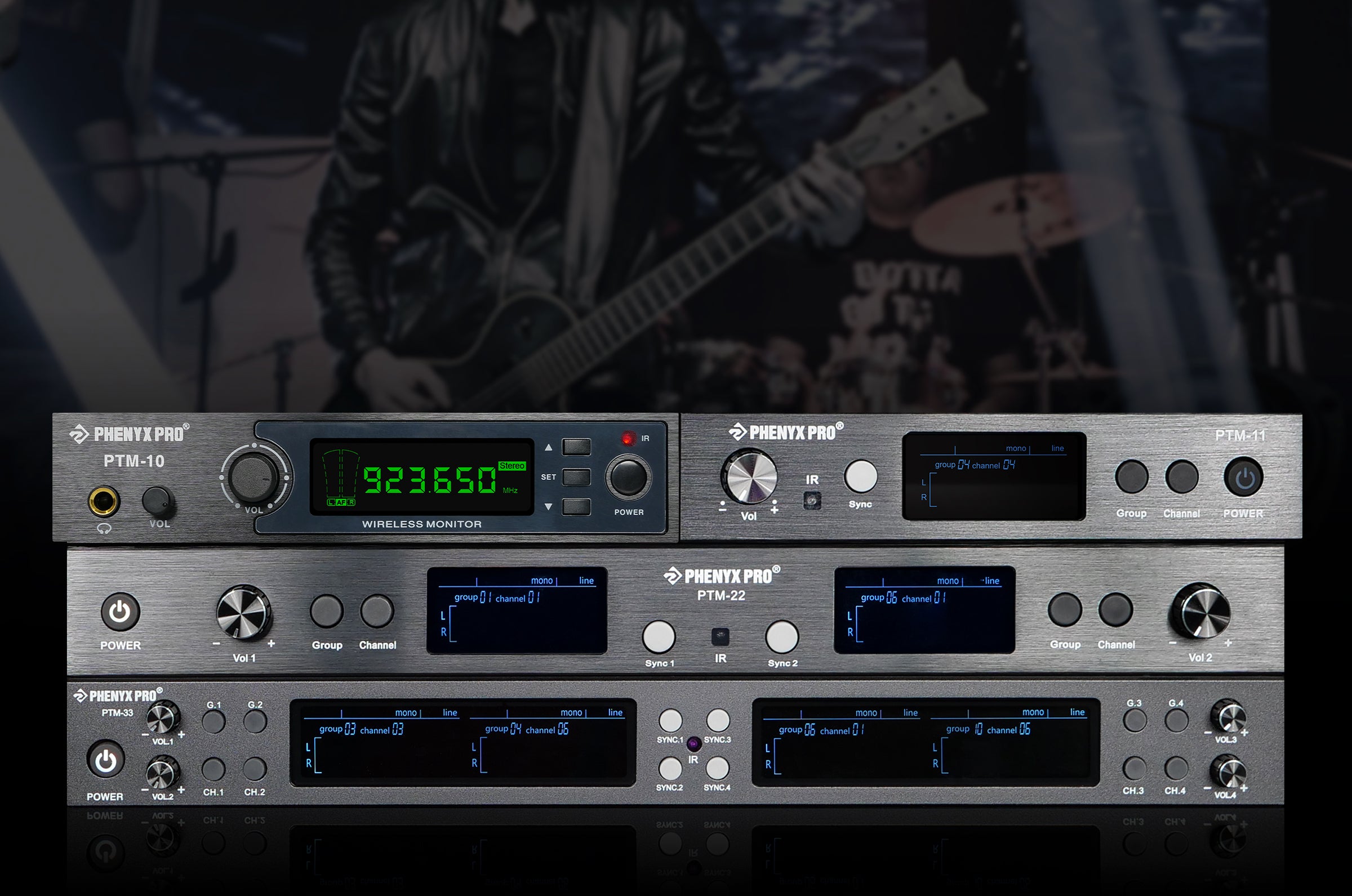
El IEM inalámbrico estéreo que te mereces
Repasando cómo fue aclamado el PTM-10 del destacado Phenyx Pro, este blog proporciona una descripción general completa de este monitor interno inalámbrico imprescindible. Ahora exploremos su experiencia de monitoreo inmersivo y su versatilidad para dominar su mezcla de monitores.
Learn More
Ha llegado el nuevo sistema de monitor intrauditivo mono PTM-33
Descubra los desafíos que plantean los monitores de escenario tradicionales para la monitorización de sonido en actuaciones en directo. En este blog, presentamos la serie de monitoreo mono de nivel básico de Phenyx Pro como una solución y destacamos la última incorporación, el sistema IEM mono PTM-33, que pronto se lanzará en mayo. Descubra cómo el innovador sistema puede mejorar su experiencia en el escenario.
Learn More
Desmitificar las caídas de señal del sistema inalámbrico
La peor pesadilla de muchas personas es que un sistema inalámbrico se corte en un espectáculo o en el escenario. Hoy analizaremos sistemáticamente las posibles causas de las interrupciones de la señal inalámbrica y los factores esenciales a considerar al solucionar problemas.
Learn More
Inicio rápido y óptimo: cómo minimizar las interrupciones inalámbricas
¿Todavía tienes curiosidad por saber cómo lidiar con las interrupciones inalámbricas? Ahora ya no necesita preocuparse porque este blog profundizará en la selección del equipo adecuado y una breve guía de configuración, que es útil para minimizar las interrupciones inalámbricas y optimizar su flujo de trabajo en rack desde el principio.
Learn More
